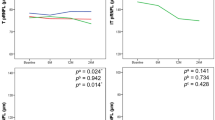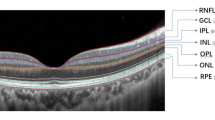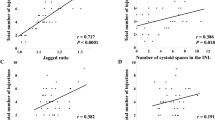Abstract
Purpose
To analyze the retinal ganglion cell-inner plexiform layer (GCIPL) changes in retinal vein occlusion (RVO) eyes with resolved macular edema using optical coherence tomography.
Methods
We compared the average and minimum GCIPL thickness in RVO eyes with fellow eyes and healthy controls including 40 unilateral RVO patients and 48 healthy subjects. The average GCIPL thickness in BRVO eyes was segmented into the affected and opposite area according to the site of lesion, comparing them with corresponding areas in fellow eyes. Furthermore, maximum central macular thickness (CMT), visual acuity (VA), and intravitreal injection times were recorded to investigate their relationship with the GCIPL thickness.
Results
Despite no significant difference in CMT (P = 0.96), the average (P = 0.02 and P < 0.001, respectively) and minimum (both P < 0.001) GCIPL thicknesses were decreased in RVO eyes with resolved macular edema after treatment in comparison to fellow eyes and healthy eyes. Maximum CMT thickness was negatively correlated with the minimum GCIPL thickness (r = − 0.47, P = 0.003). VA and average GCIPL thickness were associated (rs = − 0.49, P = 0.002). In a subgroup analysis that only included BRVO patients, the opposite area revealed no significant difference between two eyes (P = 0.91) although the affected area in BRVO eyes was decreased (P < 0.001).
Conclusions
A decrease of GCIPL thickness in RVO was observed even after anatomic restoration and associated with VA prognosis. These GCIPL defects could be attributable to systemic risks and RVO itself, not anti-VEGF effects.




Similar content being viewed by others

References
Campa C, Alivernini G, Bolletta E, Parodi MB, Perri P (2016) Anti-VEGF therapy for retinal vein occlusions. Curr Drug Targets 17(3):328–336. https://doi.org/10.2174/1573399811666150615151324
Rogers S, McIntosh RL, Cheung N et al (2010) The prevalence of retinal vein occlusion: pooled data from population studies from the United States, Europe, Asia, and Australia. Ophthalmology 117(2):313–9.e1. https://doi.org/10.1016/j.ophtha.2009.07.017
Cetin EN, Bozkurt K, Parca O, Pekel G (2019) Automated macular segmentation with spectral domain optical coherence tomography in the fellow eyes of patients with unilateral retinal vein occlusion. Int Ophthalmol 39(9):2049–2056. https://doi.org/10.1007/s10792-018-1039-3
Vilela MA (2020) Use of anti-VEGF drugs in retinal vein occlusions. Curr Drug Targets 21(12):1181–1193. https://doi.org/10.2174/1389450121666200428101343
Rogers SL, McIntosh RL, Lim L et al (2010) Natural history of branch retinal vein occlusion: an evidence-based systematic review. Ophthalmology 117(6):1094-1101.e5. https://doi.org/10.1016/j.ophtha.2010.01.058
Yiu G, Welch RJ, Wang Y, Wang Z, Wang PW, Haskova Z (2020) Spectral-domain OCT predictors of visual outcomes after ranibizumab treatment for macular edema resulting from retinal vein occlusion. Ophthalmol Retina 4(1):67–76. https://doi.org/10.1016/j.oret.2019.08.009
Tang F, Qin X, Lu J, Song P, Li M, Ma X (2020) Optical coherence tomography predictors of short-term visual acuity in eyes with macular edema secondary to retinal vein occlusion treated with intravitreal conbercept. Retina 40(4):773–785. https://doi.org/10.1097/iae.0000000000002444
Alshareef RA, Barteselli G, You Q et al (2016) In vivo evaluation of retinal ganglion cells degeneration in eyes with branch retinal vein occlusion. Br J Ophthalmol 100(11):1506–1510. https://doi.org/10.1136/bjophthalmol-2015-308106
Lee YH, Kim MS, Ahn SI, Park HJ, Shin KS, Kim JY (2017) Repeatability of ganglion cell-inner plexiform layer thickness measurements using spectral-domain OCT in branch retinal vein occlusion. Graefes Arch Clin Exp Ophthalmol 255(9):1727–1735. https://doi.org/10.1007/s00417-017-3710-1
Bonnin S, Tadayoni R, Erginay A, Massin P, Dupas B (2015) Correlation between ganglion cell layer thinning and poor visual function after resolution of diabetic macular edema. Invest Ophthalmol Vis Sci 56(2):978–982. https://doi.org/10.1167/iovs.14-15503
Wolf-Schnurrbusch UE, Ceklic L, Brinkmann CK et al (2009) Macular thickness measurements in healthy eyes using six different optical coherence tomography instruments. Invest Ophthalmol Vis Sci 50(7):3432–3437. https://doi.org/10.1167/iovs.08-2970
Mwanza JC, Oakley JD, Budenz DL, Chang RT, Knight OJ, Feuer WJ (2011) Macular ganglion cell-inner plexiform layer: automated detection and thickness reproducibility with spectral domain-optical coherence tomography in glaucoma. Invest Ophthalmol Vis Sci 52(11):8323–8329. https://doi.org/10.1167/iovs.11-7962
Mwanza JC, Durbin MK, Budenz DL et al (2011) Profile and predictors of normal ganglion cell-inner plexiform layer thickness measured with frequency-domain optical coherence tomography. Invest Ophthalmol Vis Sci 52(11):7872–7879. https://doi.org/10.1167/iovs.11-7896
O’Mahoney PR, Wong DT, Ray JG (2008) Retinal vein occlusion and traditional risk factors for atherosclerosis. Arch Ophthalmol 126(5):692–699. https://doi.org/10.1001/archopht.126.5.692
Bhagat N, Goldberg MF, Gascon P, Bell W, Haberman J, Zarbin MA (1999) Central retinal vein occlusion: review of management. Eur J Ophthalmol 9(3):165–180. https://doi.org/10.1177/112067219900900304
Ng DS, Chiang PP, Tan G et al (2016) Retinal ganglion cell neuronal damage in diabetes and diabetic retinopathy. Clin Exp Ophthalmol 44(4):243–250. https://doi.org/10.1111/ceo.12724
Shin YI, Lim HB, Koo H, Lee WH, Kim JY (2020) Longitudinal changes in the peripapillary retinal nerve fiber layer thickness in the fellow eyes of unilateral retinal vein occlusion. Sci Rep 10(1):7708. https://doi.org/10.1038/s41598-020-64484-5
Karaca C, Karaca Z (2018) Beyond hyperglycemia, evidence for retinal neurodegeneration in metabolic syndrome. Invest Ophthalmol Vis Sci 59(3):1360–1367. https://doi.org/10.1167/iovs.17-23376
Stewart RM, Clearkin LG (2008) Insulin resistance and autoregulatory dysfunction in glaucoma and retinal vein occlusion. Am J Ophthalmol 145(3):394–396. https://doi.org/10.1016/j.ajo.2007.11.005
Fraenkl SA, Mozaffarieh M, Flammer J (2010) Retinal vein occlusions: The potential impact of a dysregulation of the retinal veins. Epma j 1(2):253–261. https://doi.org/10.1007/s13167-010-0025-2
Pinhas A, Dubow M, Shah N et al (2015) Fellow eye changes in patients with nonischemic central retinal vein occlusion: assessment of perfused foveal microvascular density and identification of nonperfused capillaries. Retina 35(10):2028–2036. https://doi.org/10.1097/iae.0000000000000586
Mittal M, Siddiqui MR, Tran K, Reddy SP, Malik AB (2014) Reactive oxygen species in inflammation and tissue injury. Antioxid Redox Signal 20(7):1126–1167. https://doi.org/10.1089/ars.2012.5149
Pelosini L, Hull CC, Boyce JF, McHugh D, Stanford MR, Marshall J (2011) Optical coherence tomography may be used to predict visual acuity in patients with macular edema. Invest Ophthalmol Vis Sci 52(5):2741–2748. https://doi.org/10.1167/iovs.09-4493
Shaheer M, Amjad A, Saleem Z (2019) Retinal ganglion cell complex changes after intravitreal bevacizumab for diabetic macular edema. J Coll Physicians Surg Pak 29(5):426–429. https://doi.org/10.29271/jcpsp.2019.05.426
Beck M, Munk MR, Ebneter A, Wolf S, Zinkernagel MS (2016) Retinal ganglion cell layer change in patients treated with anti-vascular endothelial growth factor for neovascular age-related macular degeneration. Am J Ophthalmol 167:10–17. https://doi.org/10.1016/j.ajo.2016.04.003
Shin HJ, Shin KC, Chung H, Kim HC (2014) Change of retinal nerve fiber layer thickness in various retinal diseases treated with multiple intravitreal antivascular endothelial growth factor. Invest Ophthalmol Vis Sci 55(4):2403–2411. https://doi.org/10.1167/iovs.13-13769
Hosseini H, Razeghinejad MR, Nowroozizadeh S, Jafari P, Ashraf H (2010) Effect of macular edema on optical coherence tomography signal strength. Retina 30(7):1084–1089. https://doi.org/10.1097/IAE.0b013e3181d8e7d1
Yin S, Gardner TW, Thomas TO, Kolanda K (2003) Light scatter causes the grayness of detached retinas: implications for vision loss in retinal detachment. Arch Ophthalmol 121(7):1002–1008. https://doi.org/10.1001/archopht.121.7.1002
Ho J, Sull AC, Vuong LN et al (2009) Assessment of artifacts and reproducibility across spectral- and time-domain optical coherence tomography devices. Ophthalmology 116(10):1960–1970. https://doi.org/10.1016/j.ophtha.2009.03.034
Acknowledgments
The authors alone are responsible for the content and writing of the paper.
Funding
The authors declare that no funds, grants, or other support were received during the preparation of this manuscript.
Author information
Authors and Affiliations
Contributions
All authors contributed to the study conception and design. Material preparation, data collection and analysis were performed by Zhaoxia Zheng, Meng Yan, Lu Li, Duo Zhang, and Lina Zhang. The first draft of the manuscript was written by Zhaoxia Zheng, and all authors commented on previous versions of the manuscript. All authors read and approved the final manuscript.
Corresponding author
Ethics declarations
Competing interests
The authors declare no competing interests.
Ethics approval
Approval was obtained from the ethics committee of the Affiliated Hospital of Qingdao University. The procedures used in this study adhere to the tenets of the Declaration of Helsinki.
Consent to participate
Informed consent was obtained from all individual participants included in the study.
Consent to publish
Not applicable.
Additional information
Publisher's Note
Springer Nature remains neutral with regard to jurisdictional claims in published maps and institutional affiliations.
Rights and permissions
Springer Nature or its licensor (e.g. a society or other partner) holds exclusive rights to this article under a publishing agreement with the author(s) or other rightsholder(s); author self-archiving of the accepted manuscript version of this article is solely governed by the terms of such publishing agreement and applicable law.
About this article
Cite this article
Zheng, Z., Yan, M., Li, L. et al. Analysis of ganglion cell-inner plexiform layer thickness in retinal vein occlusion with resolved macular edema. Int Ophthalmol 43, 655–664 (2023). https://doi.org/10.1007/s10792-022-02569-y
Received:
Accepted:
Published:
Issue Date:
DOI: https://doi.org/10.1007/s10792-022-02569-y



